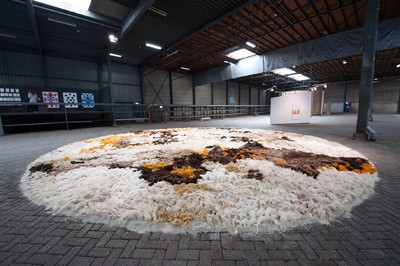claudy jongstra
Claudy Jongstra (Roermond, 1963) designs tapestries and monumental installations of textile art. Her works distinguish themselves through a strong expression and highlight the beauty of natural materials, plant dyes and craft techniques. She endeavours to bring tactility and softness into public spaces, ‘touching’ the senses. In creating her pieces, she collaborates with architects and clients throughout the world. Claudy Jongstra is devoted to the process of creation, and this includes keeping bees, cultivating a botanic garden and growing plants for their dyes.
Claudy Jongstra studied fashion design at the University of the Arts, Utrecht. Her work can be viewed at the Catshuis, the Embassy of The Netherlands in Berlin and in various museums in the United States. She received the Amsterdam Prize for the Arts (2005) and the Prins Bernhard Culture Fund Prize for Applied Art and Architecture (2008).
World farm for the future
To my utter surprise, right near our village, between the fields and the edge of the wood, a children’s farm appeared. I didn’t understand what children found appealing about looking at two goats, a donkey, a sleepy cow and some chickens behind fences. Surely those animals walked around every garden, every field? But my mother said: ‘Not everyone has a garden. Such a children’s farm is for city children who don’t know what a cow looks like.’ City children, my mother told me, thought that milk came from a carton and not from an udder. I found those children dumb, for how extraterrestrially far removed could you be from what ought to be normal in life? That’s what I thought, as a child, forty-five years ago.
It is that estrangement which artist designer and pretty profound romanticist Claudy Jongstra (1963) targets. The estrangement between city and countryside that has developed over the twentieth century, between nature and culture. The consequences of it can be seen all around us: ancient cultural landscapes are destroyed, animal, insect and plant species are forgotten or extinct, centuries of handed down knowledge of how to sow and harvest, how to dye and weave, how to churn and shear is disappearing. And for that which remains, not only young people but many elderly too have little eye.
There is another way, so German philosopher Peter Sloterdijk claims. There must be another way. ‘Act such, that the consequences of your actions harmonise with the continuation of human life on earth,’ he proposes.
Jongstra has lived and worked according to that maxim since her 1994 graduation from the fashion department at the Hogeschool voor de Kunsten in Utrecht. Her trademark becomes felt: an honest and sober material that, in the textile and fashion industries, dangles somewhere at the bottom of the hierarchical ladder. Jongstra designs rugs and tapestries out of felt. They offer protection from the cold and other discomforts, they are stunning and caressible. Her felt works are all naturally dyed, the colours coming from madder, walnut, calendula, St. John’s wort, camomile, onion peel. Everything has been endlessly boiled, dried, boiled again, to simply see what happens. That natural colouring adds a radiant allure to Jongstra’s work, with an infinitely greater number of nuances than chemical colourings could ever offer.
Jongstra lives and works in Friesland, where she keeps dye gardens, kitchen gardens, farmland and a herd of grazing Drenthe sheep she gets her wool from. Her work has found its way to prestigious museums, like the Stedelijk Museum in Amsterdam and the MoMA in New York, the catwalk of a show by John Galliano, the Dutch Embassy in Berlin and many more. For 2018, in the context of Leeuwarden Cultural Capital, the idealistic and ambitious Farm of the World is planned — a sustainable project she is developing with Gitta Luiten, former director of the Mondriaan Fonds, and Claudia Busson in the Frisian village of Húns. Farm of the World is a farm for the future, by and for artists, cooks, designers, young people, architects, ecologists. At this farm, only natural resources are used. Therefore you won’t find a machine in Húns — everything is done by hand. City children are invited to Húns for workshops. Intensive agriculture is nowhere to be found, ecological diversity comes first.
A small version of Farm of the World now grows outside the Noletloodsen. On a piece of polluted land lies an adventurous ‘pop-up garden’, as Jongstra calls it, bordered with wire netting draped with felt tufts from Jongstra’s sheep. The garden undulates slightly, lawn turfs form geometrical patterns and elegant tracks. From willow twigs, a hut was built to provide shelter for birds and small field mice. Camomile and calendula were sown — gentle, medicinal flowers that enrich the polluted earth. Whether this pop-up garden will remain here forever — which I genuinely hope it does — depends on the zoning plan of these grounds.
Inside the warehouse lies a carpet of felt strings in every shade off-white to beige, golden yellow to walnut brown. This carpet cannot be trodden, only viewed from the sidelines. And then you see a medley of threads, loosely entangling and branching out again. Head to tail, tail to head. Nothing ever loosens again, yet all is loose at the same time. That is the most precious metaphor of life imaginable.


